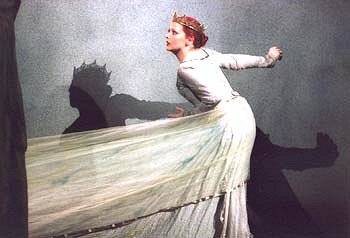ENO's brilliant staging (expanded from Opera North's 1995 production by Richard Jones) brought the human drama of Pelleas & Melisande alive and grippingly close, from first moment to last.
[Photograph: Bill Rafferty]
A long grey wall, a barrier with three closed doors, confronts Golaud and ourselves. This creates an immediate and uncomfortable sense of exclusion, underpinning Golaud's display of frightening disorientation. A distressed Melisande emerges slowly, dragging an enormous train, its end remaining hidden inside the half-open door. With breath-taking simplicity we are made aware that she is trapped by her own history, which we cannot fathom and never learn. Golaud sees this entrancing fragile, eroticised, red-haired stranger as his salvation. During their dance-like first encounter she weaves her winding sheet around him. Neither of them can now escape their sad fates and we, the audience, are likewise caught and gripped, observing and listening to the tale of doom unfolding. The singers' movements and at times meaningful stillness (movement director Phillippe Giradeau) created body languages expressing inner states of great intensity.The stage picture (Antony McDonald) reminds us of disturbing surrealist art. The costumes relate also to symbolist representations. The superb curtain, which we contemplate through each of the long interludes between the scenes (given for the first time at the Coliseum in Debussy's later version) shows a tiny, isolated house with no door, no access, stranded on a shore, incongruously casting a spiky shadow akin to a church tower, obliquely upwards towards towering waves. Instead of weightless sky, the scene is trapped by heavy water. There is no attempt to distance the story with fairy tale forests and castles.
The sense of isolation and alienation is reinforced by the division of the house into three stark white cubicles without connecting doors, in which the indoor action takes place. We have an uncomfortable sense of intruding as spectators, as if witnessing harrowing scenes in a hospital and/or prison. This part of the scenery tilts down towards the right, creating a visual metaphor for the pull of fate towards death, whether physical or emotional. This striking, stark visual symbolism counterpoints and contrasts with the continuous, mellifluous music, which rarely raises its voice - the power of the one reinforces the power of the other through their differences, creating a meaningful synthesis.
The musical values are quicker to deal with. Too many superlatives make for dull reading; suffice to say that under Paul Daniel's undemonstrative direction of the orchestra, which played with the greatest sensitivity for him, Gary Magee (Pelleas) Joan Rodgers (Melisande) Robert Hayward (Golaud) Clive Bayley (Arkel) and Rebecca de Pont (Genevieve) worked marvellously together, locked in their several inner isolations, becoming as fine a cast of protagonists as we are ever likely to see and hear.
Hugh Macdonald's clearly audible English version made for additional immediacy. In his perceptive introduction to the comprehensive essays in the lavish (and pertinently illustrated) programme book, he suggests that the very ordinariness of the language, radical for an opera of the time, only deepens the obscurity of what it means. This is a crucial dimension of the Maeterlinck/Debussy creation, which can only be appreciated in the language of the audience. This was an ENO performance in which everything was right, everything looked right and fitted smoothly together, a joy to be there - a thoughtful and meaningful recreation of a unique, but ever elusive, peak in the operatic repertoire. It should be committed to DVD and to CD, with every effort to maintain a balance between voices and orchestra similar to that heard in the Coliseum.
Alexa and Peter Woolf

 Return to:
Return to: